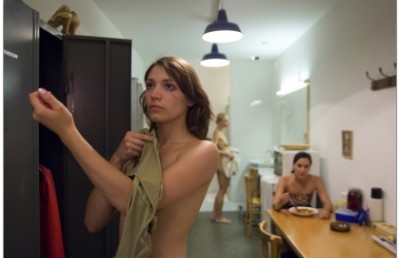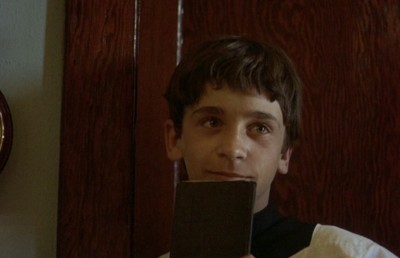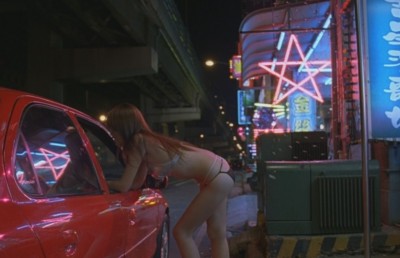Vancouver International Film Festival 2009
Four Long Glances
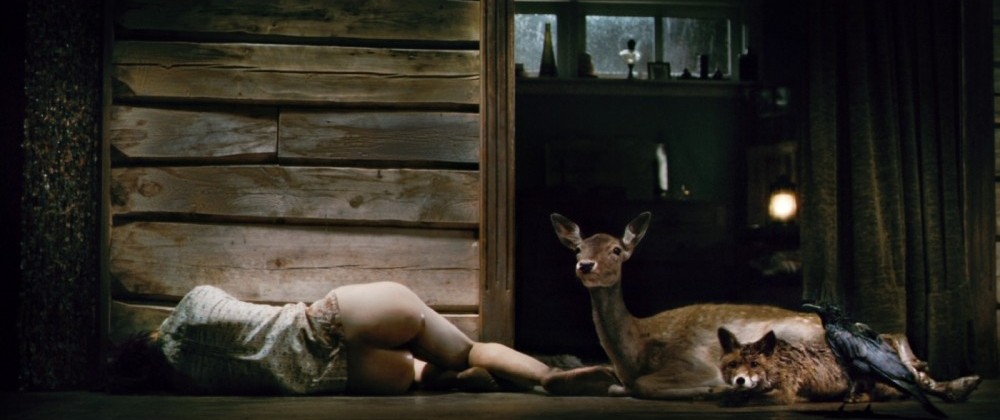
It’s always perilous to speculate about trends based on festival viewing, particularly in my hype-free hometown. For the serious viewer, the Vancouver International Film Festival experience is hopelessly personal: the number of choices (over three hundred films) combined with the relative lack of media attention, tends to promote more personal, idiosyncratic decision making. And the more you see, the more the possibilities of the art form expand, which further works against generalizations. Aside from some clearly visible stylistic trends in contemporary art cinema, there’s not much I can say to unite the chaotic experience of my festival-going life, short as it is so far. Attending the VIFF in the fall, I saw films about seemingly retarded hobos, reluctant policemen, quarrelsome lovers, the manufacture of bricks, Hitchcock and the Cold War, brutal torture, and much more. I can’t begin to make generalizations about the state of world cinema based on the seventeen films I saw. What I offer instead are reviews of the four films that I found the most noteworthy.
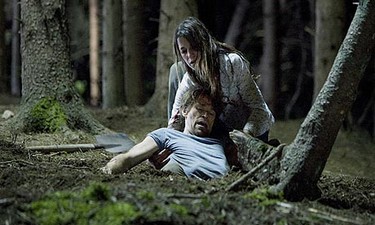
Antichrist closes with a dedication to Andrei Tarkovsky. What are we to make of this, assuming that director Lars Von Trier is being serious? (On the evidence of the film itself, there’s no way to know.) The main thing I can think of that Antichrist shares with Tarkovsky’s work is its heavily verbalized, counterproductively tangential rendering of theme; but then, that was a trend that reached much farther than Tarkovsky, especially in the Sixties and Seventies. It’s a tendency that’s been scaled back considerably in our current art cinema culture of laconic minimalism; maybe the most interesting thing about Antichrist is the sense of nostalgia it evokes. It builds a bridge back to the glory days of European art cinema, when filmmakers verbalized their demons through high-toned dialogue and the intellectual stakes were as high as you could get. Antichrist addresses grief, mortality, sexuality, gender, and nothing less than the fundamental moral nature of the physical world. It’s tempting to call Von Trier ambitious and leave it at that, but that’s assuming his ambition in throwing his lot in with big boys like Strindberg, Bergman, Oshima, and Tarkovsky (?) can be read straight.
The film starts in what at first seems like flagrant Adrian Lyne mode. Handel plays on the soundtrack over monochrome images of candy apple glossiness. He and She (Willem Dafoe and Charlotte Gainsbourg) make love in the shower. Their archetypally familiar slow-mo thrusting is intercut with shots following their small child as he climbs to a window and plummets to his death in soft, powdery snow. The connection between sex and punishment is too obvious to be worth dwelling on in any detail; what’s fascinating about this prelude is its evocation of Griffith at his most inspired and literal minded. It’s a refreshingly old-fashioned riff from Von Trier, silly and exciting in the Silent tradition of crude poetic juxtaposition.
He’s a psychiatrist; She’s a former grad student who worked on a thesis, soon to be resurrected, on witch hunts and misogyny. In the wake of their shared trauma they head to a cabin, called Eden, in the thick woods of rural Washington State. He begins counseling her, and the bulk of the movie consists of alternations between intense lovemaking; informal, usually abortive, counseling sessions; brutal conflicts; and, occasionally, touches that could charitably be called surreal.
Von Trier is expert at conveying a sort of rambling, diffuse tension. For much of the running time, the storytelling is discursive and episodic, yet residual spite accrues and mutual alienation grows at a steady, unambiguous rate (give or take a few sudden lurches). Von Trier uses casual pacing to further the sense of menace, and he’s very good at it. Another great thing about Antichrist is its cutting and composition –unlike in so many contemporary films, the former doesn’t outmatch the latter. Von Trier shoots in Bordwell’s Intensified Continuity style, but slows things down just enough so that the presence of the individual shot has a chance to sink in. He’s always had a great sense of shot length in relation to performance, and here as ever he knows just when to drag out a lingering handheld close-up and when to cut sharply to a reaction shot. In both the performances and the visual style, detail and spontaneity are perfectly balanced. The cutting interacts with the individual images instead of downgrading them.
It’s when the film moves from generalized animus to intellectual particulars that things fall apart. There’s some learned, combative chatter between the increasingly hostile lovers, but the ideas discussed take a backseat to the increasingly hostile power play –not the first time suspense has overwhelmed contemplation. There are some talking animals, some genital mutilation, and various thematic riffs that are either an exploration or an expression of raging misogyny. The difference between this movie and Breaking the Waves (1996) or Dancer in the Dark (2000) is that the psychology is talked out intelligently –and quite realistically, overall– by the characters themselves. Like a lot of filmmakers, Von Trier seems to allow for more complexity in his characters as he moves up the class scale. The angelic proletarian airheads of Waves and Dancer are quite a few notches below mobster’s daughter Grace in Dogville (2003) and the thoroughly middle class She. These latter characters’ talk is less pop-trite, more elaborate, infinitely more articulate.
She resents He because he takes their son’s death so well; He manipulates her in order to free her; He fears her emotions and so does She; She fears nature more and more the closer she comes to a state of unthinking animalism- most of the (legible) discourse is simple, some of it less so. But these issues, talked out as they are, seem to exist in a strange parallel to the portentous-facetious nature symbols that don’t so much lurk in the background as pop into view and then disappear at certain moments. As often with Von Trier, there’s a cod Christianity present, in this case a transcendental abhorrence of the physical, mortal world. Most people I’ve read or spoken with seem to agree that it boils down to something like: Nature=Woman=Chaos and Brutality. It’s hard to accuse the filmmaker of misogyny when he shows so much careful attention to Gainsbourg’s defiant individuality, yet it’s hard to dismiss the charge when faced with the image of women with blanked out faces converging like buzzards on a castrated male amid the harsh, rough greenery. (“Nature is Satan’s church.”) And it’s hard to know how serious he is about the whole deal when he throws in outrageously risible stuff like a digitally animated, self-disemboweling fox telling He that “Chaos reigns.” The problem is not that Von Trier is ambivalent about his material; the problem is that he’s ambivalent about how to treat his material. Contradiction is a virtually unavoidable part of narrative filmmaking; masters like Franju and Von Trier’s oft-cited model Dreyer could embed a mass of contradictions within a single shot. But their passion was never in question. And Von Trier doesn’t so much mix compassion and irony so much as alternate them, and it manifests like a dialectic without a synthesis.
Almost everyone I’ve ever read or talked to in regards to Von Trier –defenders and detractors alike– seems to throw up their hands in the final analysis. Some of them like doing it more than others. It feels like the biggest dividing line is between those who see his two-toning as brave and those who see it as a copout. I stopped hating Von Trier when he stopped connecting stupidity with virtue in his slow-burn female martyrdom orgies. Like Grace in Dogville, Gainsbourg’s She is a strong, intelligent, fully formed character, and the director seems to respect her passion –quite different from alternately ridiculing and exalting it, as was his old habit. With Dogville, Antichrist is probably the best Von Trier I’ve seen. But at the end of it I was left with the same old infuriating question: why is this guy so afraid of his own ideas? It’s possible that thousands of us are wrong about him; that the talking foxes and bathetic musical lyrics and arch BBC-British voiceovers of his films are meant as seriously as the vivid, hovering camera gaze, the intensely physical action and the superbly emphatic performances. We could be misreading him. But all anyone can do is guess.
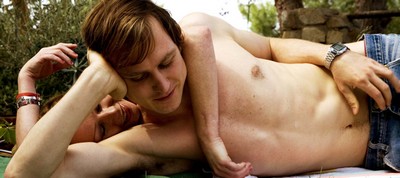
Maren Ade’s Everyone Else is a relationship movie, maybe one of the relationship movies, but it’s not really the story of a relationship. There’s a narrative arc guiding the ambling, casual plot, and it’s certainly not without its implications, but the movie feels cut off at either end. You don’t come out of it knowing much about what happened before or what will likely happen after what you’ve just seen. You could call it an extracted core sample of a few days in the life of a couple. The film operates at a casual, clear-eyed remove, with episodic plotting, naturalistic performances and no interiority; it gives the pleasures of naturalistic immersion and forensic distance in equal measure. Typical of its air of mystery is that in a work so lucid and detailed –a film in which we learn so much– the full implication of what we see is unclear. These few days and nights could be the end of couples’ time together, or somewhere near the beginning, or smack dab in the middle.
Chris (Lars Eidinger) and Gitti (Birgit Minichmayr) are a German couple in their thirties vacationing at the former’s family home in Sardinia. Chris is an as yet unsuccessful architect; his albatross is his mixture –familiar among artists– of naïve, finicky idealism and cynical, iconoclastic disdain. Gitti does media-relations work for a record label; she’s feisty and volatile, a source of mystery and frustration for Chris. She’s a much stronger person than him –his sense of gender-role humiliation is a key element of the movie, and the fact that Everyone Else is so wonderfully free of masculinist self-pity is surely due not only to its director’s gender, but to her studious sense of detachment and balance. The crises that unfold between Chris and Gitti are of ultimately unknowable significance, and this detracts from the movie’s power not one wit. It’s a talkative but reticent film, an intricately suggestive riff on unintended implications, shifting power dynamics and the paradoxes of communication. All of the revelations and markers let themselves in quietly, indirectly. Everyone Else redeems a type of storytelling that has a bad rap in some highbrow circles: it’s all about the elaborate concealment of discourse under carefully cultivated realism and drama.
This is the type of movie that gets praise first and foremost for its dialogue and acting, but that shouldn’t overshadow the visual achievement here. Ade maintains a painstakingly equivocal balance between foreground (character) and background (environment) and holds it for almost every shot. We’re never in doubt as to the dominant contrast (a human character in virtually every image –quite rare in cinema), even temporarily. But it’s impossible to decontextualize behavior –even slightly– while you’re watching the movie. The characters are enmeshed in their environment without being trapped. That’s the essence of the balance –between constraint and freedom, determinants and chaos. It’s a visual analysis of moral agency. Ade is doggedly focused and seems to be looking for essentials in her characters, but the world she’s constructed has a huge allowance for chance. Every line of dialogue, every opinion expressed, every conversational revelation has a disturbing contingency.
What Everyone Else offers is subtext in rapid motion and constant redefinition; it’s an extremely generous film in this sense. Chris is happy with Gitti being the more energetic, “masculine” partner, but feels he can reserve the right to a higher prerogative. Gitti thrives on Chris’s passivity when it involves her but is repulsed by it in the context of Chris’s professional life. Chris dislikes Hans (Hans-Jochen Wagner), a colleague of his from Germany, but when faced with him turns submissive and receptive; he responds to Hans’ entreaties to give up detached idealism and get his hands dirty with actual work while having ignored the same message coming from Gitti. For her part, Gitti resents Hans’s entreaties, even though she’s said the same things to Chris. Chris and Gitti start to get hostile; Chris is only conciliatory with her once he accepts from Hans what he earlier rejected from her; at this point he starts to perform, assuming a conventional masculine role he’s been rejecting up to now. This presumption angers Gitti, for at least a few reasons, one of which seems to be that she’s let down by how easy he can change –despite the fact that that’s exactly what she wanted him to do.
The film bristles with complications and contradictions like this; the above are just the most obvious ones. They’re outlined as discreetly and precariously as the visual negotiation between people and setting; they refract through and qualify each other endlessly; and it’s all brought out by simple, naturalistic conversation. Typical of the film’s level of unassuming, incidental complexity is a scene towards the end. Chris and Gitti are having a serious talk; Chris launches on a monologue, and Gitti thinks he’s talking about their relationship. After the alienation and discord they’ve been through, she starts to warm to him again. For a few seconds it seems like we’re at a turning point back towards relative harmony between the two. She gives him a generous, considerate response and Chris dismissively says “I’m not talking about us.” For him, she’s missed the point; for her, he’s missing the point. For both of them, it’s serious. Her hurt feelings are just the collateral damage of the point he was trying to make –a point that’s important as hell to him at the time but that will probably fade in relevance, perhaps unlike the hairline emotional damage he’s just caused. Few other movies have illustrated so perfectly the half-blind danger of conversation.
Everyone Else is masterfully convincing on the surface level, and everything there points to a complex of implications that’s wide-ranging and obstinately local at the same time. And for all the refined, old-fashioned verisimilitude, the movie promotes a modernist distance; luckily, it’s not forceful enough to spoil our fun. Like most great modernist texts, Everyone Else creates distance through a sort of heightened formal self-definition. In this case, as often with movies, that definition is expressed through a strong sense of limitations. We do learn a lot about Chris and Gitti. But the film has an incredibly stubborn exteriority. There’s no rhetoric to take us in beneath the surface –no musical cues to hint at a character’s mood, no visual subjectivity, no general privileging of one character’s perspective, no more than a short-term arc to outline destiny and flesh out character. There are walls around this film, no matter how open it is towards garrulous humanity. Ade refuses to tell us anything; what she does is show. Chris and Gitti give us a lot, but it’s somehow inadequate in conventional movie terms. All we are allowed to know is what they accidentally reveal about themselves. It’s a verisimilitude with an unusual sense of boundary; what Ade shares with her German peers Valeska Grisebach, Christian Petzold, and Stefan Krohmer is an ability to complicate realism without undermining it.
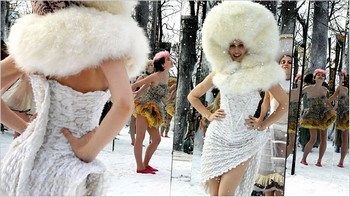
Tsai Ming-liang’s Face is a film I went to with a little anxiety. Tsai is my favourite narrative filmmaker, but he’s been slipping in recent years, and word from Cannes was that it was a failure –“misfire” was a phrase I read more than once. My worries were wiped out before the first shot ended. It’s an initially unassuming image that slowly increases in intricacy. The camera faces the window of a coffee shop, the dominant contrast shifting between objects in front of and reflected in the pane. Tsai gives you some subtly nudging guidance and as much time as you need to do what you want with the shot: you can stare at one object or another, the transparent parts of the glass or the reflections. Time is on your side; Tsai’s camera stares and stares and tiny things change beautifully. Throughout the film he uses the static frontality of the camera to throw light, colour and shape into miraculous relief: he’s one of those directors, the heroes of art cinema’s recent past, with whom the funs starts once you think you’ve finished assimilating the shot. Tsai is a master of the glacially paced revelation, never more so than here.
It’s hard to pin down the nature of these temporal miracles, besides citing the obvious magnification of time and physicality. What happens after one’s finished taking in the shot is hard to talk about because the style is so open. For a lot of people –seasoned cinephiles and neophytes alike– the reaction is boredom. For a smaller number of us, it’s some kind of epiphany. A wider democratization of understanding and experience has always been one of the main aims of art cinema, but filmmakers like Tsai and Denis and Kiarostami and Apichatpong push it further than the European masters of the golden age. The radical eschewal of exposition in favour of inference; the greater distance from standard visual grammar; the use of distanciation; the rejection of conventional drama (which ranges from partial to total, depending on the film); the purposefully guileless rendering of the obvious, so that simplicity is its own alibi; and, most of all, the riveting combination of restriction and freedom that comes from shooting action in long takes with little to no camera movement. These are the attributes of one of the greatest periods in art cinema history; and if it may now be coming to a close, with the style hardening into over-familiarity, that doesn’t diminish Tsai’s achievement in the slightest.
Face has the loose continuity; the blatant, simple directness; and the sense of radical autonomy in each shot that serve to make “primitive” cinema, pace Tom Gunning, such a challenge to our received notions about the fundamentals of filmmaking. The connection between the cinema of static minimalism and early cinema is key to understanding contemporary art films and what their values are. And more than any other of Tsai’s films, this one is dedicated to the values of the Cinema of Attractions. It has the sense of isolated physicality thrown into relief against a firmly established background, of vaudeville spectacle, of open-book delivery: Tsai adjusts our expectations backwards in time. The basic, obvious frontality of the camera setups and the total disinterest in conventional narrative trained me pretty quickly to expect nothing but straightforward beauty and frissons of suggestiveness. The focus on extreme beauty may be simpleminded, but the results are stunning.
There’s Tsai regular Hsiao-kang (Lee Kang-sheng), lying draped in a shower curtain in a bathtub, with a woman daubing him with fake blood –in a tunnel under the Louvre. There’s a delicately arranged battery of women, scantily clad in haute couture and standing in the snowy woods among strategically placed mirrors mounted on the trees. There’s Hsiao-Kang and Mathieu Amalric in what has to be one of the all-time best gay love scenes: an anonymous blowjob in the bushes continually interrupted by a cell phone. It’s a wonderfully compact image, a vivid and hilarious zeitgeist snapshot that has the direct, unmediated comic pathos of Chaplin and is as conscious of time as any shot the movies have ever seen. These last two images speak to what’s best about the film: the simplicity of composition combined with comic outlandishness and a slowly developing intricacy. The look on Amalric’s face in the cruising scene changes ever so subtly as sex makes its (interrupted) progress; sometimes his expression is blank or ambiguous, other times less so. It’s a push-and-pull adventure in suggestion and explicitness, with a potent, built-in suspense. The shot of the models moving amidst the trees and mirrors is a low-key, kaleidoscopic orgy of small-scale visual flux. In many shots it’s difficult to tell how much improvisation was involved. Tsai ruthlessly but broadly defines his parameters, which gives him acres of freedom to allow for spontaneity: there are changes in the available or artificial light, animals enter and exit the frame with what seems like a miraculous felicity, an exposed water line gushes this way and that across a room as Hsiao-Kang struggles to block it or shut it off. For me, the greatest pleasure in cinema is seeing things redefine themselves without camera movement or cutting, and on that level Face is an embarrassment of riches.
As for the plot…who cares about plot when you’re having this much fun? The program notes indicate a loose story about Hsiao-Kang involved in shooting an adaptation of Salome around the Louvre, and there’s business with Jean-Pierre Leaud as a possibly senile actor, a lost deer that is somehow essential to the production, the death of Hsiao-Kang’s mother, and model Laetitia Casta as an actress having some love troubles. This all might become clearer on a second viewing, but after about half an hour into the film I got the feeling that it didn’t matter much. There’s an oneirically suggestive implication in many of the scenes: a costumed Leaud emerging from underground into a hallway in the museum, entering the frame from a hidden panel beneath mounted Old Masters; Casta mournfully covering a window with black tape; a beautiful scene with Leaud and Hsiao-Kang sitting in the snowy forest amid cameras and filming equipment, reciting names of famous filmmakers and actors and smiling with joy and recognition. It’s all pretty fragmented, and seems to make about as much sense as David Lynch or Apichatpong Weerasethakul at their loopy best. The disappointment of some critics over this movie may reflect a disorientation in terms of their expectations; most of Tsai’s films feature minimal but very tight and legible plotting, and the concerns –e.g. loneliness and alienation as it relates to modern geography– are much clearer. What vague themes there are here (the power of cinema to transcend death, the absurdity involved in making even the most serious art), they don’t seem much articulated by plotting. Each scene stands alone with its implications to a greater degree than in most of Tsai’s work. And what’s wrong with that? Critics may find nothing more than discontinuous suggestiveness in the film; all I can say is, that never seemed to be a problem with Lynch’s Inland Empire (2006), Apichatpong’s Syndromes and a Century (2006), or Roy Andersson’s Songs From the Second Floor (2000). Those, not Vive L’Amour (1994) or The Hole (1998), are the apt comparisons.
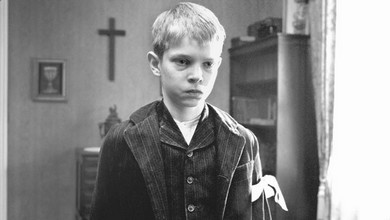
It’s always irked me that Michael Haneke likens himself, however humbly, to Bresson. Bresson works paradoxically from seeming insubstantiality; Haneke’s images have a glowering, oppressive ballast to them. Or, in more concrete terms, Haneke’s shots are much, much longer. By far the more apt comparison (and it’s still a comparison that embarrasses Haneke’s work) is with Dreyer. I’d grant that Bresson is a key part of the stylistic lineage that informs today’s hyper-focused art cinema (a tradition that Haneke, up to this latest film, is surely a part of), and that Haneke shares his strictness. But Bresson, for all his severity, has a light touch; Haneke’s is like hand around your throat. In The White Ribbon, the grip has loosened stylistically (bad news) but tightened on a thematic level (even worse news). The film is an arthouse-genre fence sitter, a mystery thriller with a slow pace and a metaphor at the centre of its story that feels both laughably broad and pretentiously vague. The plot, mood and –to a lesser degree– images of the film have a superficial similarity to Dreyer’s Ordet (1955) and Day of Wrath (1948). But the movie’s real kissing cousins are Invasion of the Body Snatchers (Don Siegel, 1956), Village of the Damned (Wolf Rilla, 1960) and Le Corbeau (Henri-Georges Clouzot, 1943). It’s a minor shame that the filmmaker didn’t stick closer to Dreyer; for all the gap in intelligence he’s still on safer turf there. But the foundations of this movie are its thriller plot, on which level it’s inept and inert, and its political thesis, which is that –surprise, surprise– economic inequality, patriarchy, and authoritarianism are linked!
The film is set in a small Austrian village just before the outbreak of WWI. The plot is set in motion by a series of violent, antisocial acts —some explained, some not— that spread through the community like a plague, creating suspicion and dread among the inhabitants. Tripwire fells a horse and injures its rider, a disabled boy is tortured, a domesticated bird is found stabbed through the chest. Everyone is under suspicion, and the lack of clear resolution at the end seems to serve as nothing more than a way for Haneke’s condemning attitude towards the village to take on an unearned metaphysical weight. The plotting, which tries and fails to be wide-ranging and episodic while maintaining suspense, moves between discovery of these crimes and glimpses into the lives of the feudal village’s inhabitants. The film is narrated by a local schoolteacher (Christian Friedel), recalling the events as an old man. He’s one of the only characters who is neither a perpetrator nor an abject victim of cruelty, and Haneke clearly intends him to be the moral center of the film –tellingly, he leaves the village at its end. In his combination of detachment, narrative authority and moral distinction from this rotten town’s inhabitants the schoolteacher seems to be a flattering surrogate for the filmmaker. It’s the most offensive thing in the movie, and it’s key to the central and oft-cited flaw in Haneke’s work: he remains morally detached from the sins he portrays, too cowardly or arrogant to implicate himself in the world of his characters. I hope that on some level he’s smart enough to realize that the character he most resembles in this movie is not the narrator but the humourless, punitive local pastor (Burghart Klaußner): a stern moral arbiter, lonely in his professed virtue, who punishes people for their own good.
The monotonous moralism relates to the willfulness with which Haneke relays information. There’s the seemingly arbitrary alternation between direct presentation of story moments and voiceover exposition (which sucks all the suspense out of the film). There’s also the randomness of his choosing what to have us see for ourselves (often lengthy “chamber” scenes between two characters) and what to have us hear other characters talk about (they’re all gossips, of course). From a storytelling point of view, what remains onscreen and what is left off is purely random –every moment could just as well have been talked about or narrated instead of seen, and vice versa. Faced with the randomness, we’re none too subtly provoked into asking what motivates Haneke to show (and not tell) the things he does. And the answer is almost always the same: to convey misery and injustice, and connect them clearly (so clearly!) with the old warhorses: patriarchy, economic servitude and inequality, and religion. It’s a bullying, mulish insistence; Haneke jumps from character to character not to convey a sense of variety, but as proof of an engulfing uniformity.
The White Ribbon is a salad wagon for the enlightened arthouse audience; it reminds me of the wonderful comment that a retired Pauline Kael made about American Beauty (Sam Mendes, 1999): “The picture is a con. Can’t educated liberals see that it sucks up to them at every plot turn?” Haneke sees evil in terms of authoritarianism- hardly an original perspective, and somewhat odd for a director as aggressively strict and punitive as he is. Monstrous Christianity looms over the community; Fathers admonish, threaten, humiliate and punish children; the local doctor denounces and ridicules his lover and employee in the cruelest way imaginable, in a scene with no possible motivation but to turn the screw of moralistic repugnance in tighter. And everyone seems afraid to smile. The only exceptions to this transparently willful parade of nastiness are the scenes involving the narrator’s courtship of a quaint, virginal newcomer (Leonie Benesch). The ingredients to this plotline are straight off the rack: there’s her mixture of plucky self-confidence and innocent sexual reticence; her crusty, pragmatic but decent and warmhearted father; and the hokey counterweight of the couples’ love against the hostile circumstances. The scenes with this couple have an Andy Hardy quaintness that contrasts hilariously with the glowering air of the rest of the film. Is the storybook triteness of this subplot supposed to be ironic? Is the director capable of irony beyond the most basic, obvious level? An ironic approach to genre might have been a saving grace of the movie.
Haneke is the dictionary definition of “on-message,” and he’s as ruthlessly determined a partisan as Rush Limbaugh or Michael Moore. The indictment of consumerism, technology and conventional cinema practice in his violent “provocation” movies was broad and obvious, embarrassed by comparison with the similarly themed early work of Atom Egoyan. The buckshot blast at feudalism, Christianity and patriarchy here is insultingly presumptuous and laughably circular. Fifteen minutes into the movie it’s clear that these people are benighted and repressed: it’s in the monochrome photography, the minatory compositions, the mugging of the cast. By making this the standard from the outset, the filmmaker shortcuts the burden of proof, which is typical of his moral laziness. And it’s all so complacently sweeping, especially when he handcuffs his parade of horrors to the outbreak of the Great War with only a few minutes left in the film –a last-minute metaphor, kind of like someone throwing a punch and then running. And does anyone really need another film with the Left’s demons jammed forcefully into a distant, judgmentally recreated past? Doesn’t Haneke realize how many times his main audience has seen this stuff? Does he realize how close he’s moving to a Miramax position?
His best films –The Seventh Continent (1989), Benny’s Video (1992), The Piano Teacher (2001)– are gripping emulations of Dreyer’s tug-of-war combination of lingering intensity and glacial reserve. Haneke is (was?) a brilliant stylist, and if his sermonizing was trite, at least every shot of his films was memorable. The White Ribbon??’s antiquated monochrome gloom is derivative, Haneke’s eye for colour and shape is missed, and the film is more classical –i.e. less distinctive– in shot length and patterns of cutting. ??Cache (2005) was a thriller as well, but the anonymous surveillance conceit provided a juicy pop motivation for Haneke’s (shared) trademark style of obstinately static one shot scenes. The new film isn’t a complete break, but the visual rhetoric seems diluted in convention to a large degree. And in the scenes where it tries to assert itself, it tends to stick out and arrest the flow. There’s a laughable moment when the pastor sentences his children to a caning. Haneke leaves the camera in the hall, outside the room where they’re being beaten; we hear the muffled lashings and cries through the door. It’s rhythmically disruptive, awkwardly obvious, and pretty anomalous in relation to the rest of the film –vanity posing as discretion. There are some decent tracking shots holding characters in profile while a detailed procession of village life floats by in the background. And Haneke’s visual treatment of actors is as masterful as ever; he’s great at directing his cast and framing his close-ups so people and their humanity register paradoxically: with a mixture of iconic scale and detailed, diminishing realism. (Dreyer again, and Bergman, too.) But mostly the direction registers as zero-degree style with an arty glaze of elongation. It’s Haneke’s most conventional film, and his worst. But I’m glad it was made, because it throws the central contradiction of this filmmaker into (comic) relief: he’s an antiauthoritarian authoritarian. It’s an impossible position for a serious artist.




